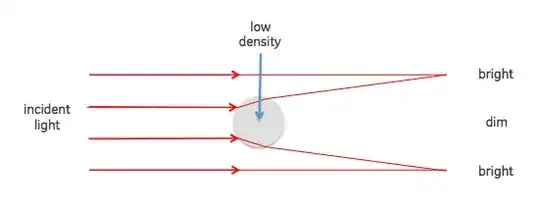The column of warm air has lower density and thus lower refractive index. This makes a cylinder of low refractive index which acts as a lens wi h a negative focal length.
Light that would have passed through the column is bent outwards, where it is added to the light that was already there. So there is a dark region directly behind the cylinder, and a brighter rim right outside it.
I hope the following diagram makes it clear:

Incidentally, the refractive index of air is quite small: 1.0002772 (at 15 °C, 1 atm). You can expect this to scale roughly with density, so if you heat the air to about 300 °C, the density drops by a factor 2x and the change in $n$ is roughly 0.00014, or 0.014%. We can estimate the focal length of a column of air that is 2 mm diameter and 300 °C:
The focal length is approximately given by
$$f = \frac{R}{\Delta n}$$
which is a simplification of the lensmaker's equation
Putting in the numbers I estimated above, we find $f = \frac{1 mm}{0.00014}= 7 m$
This means that the bright fringe will be best observed if the screen is a few meters away from the candle; if you get much beyond the focal length, the effect will start to diminish again. If the column of hot air is smaller, the focal length will come closer; the same will happen if the air is hotter.
Note that if the incident source is extended (that is, light is arriving from multiple directions), then this tends to "smear out" any effect - which is why this is most visible if you use a point (or slit) source.

